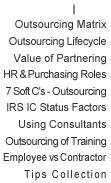Selecting vendors to fit the situation
Medieval Popes and early Scots knew about it long before modern managers. Painting the Sistine Chapel was an outsourced project; Scottish weaving mills have used home-based woolspinners for centuries; city governments have long used contractors for services; for decades businesses have engaged temporary executives.
In recent years, outsourcing has become an area of management focus. The leveraged business model is a strategic tool for many companies.
In part, outsourcing has been in response to a process we know as "downsizing". Companies now smaller than before must look for ways of doing the same work, or more, with fewer employees. Further impetus has come from the burgeoning growth of companies in the high technology industry.
Outsourcing is also a result of a shift in mindset. The traditional corporation has changed. A new, more dynamic model has a permanent workforce that constitutes only the core. The “virtual corporation” has emerged. To meet dynamic resource needs, external expertise is used in specialist areas, once the exclusive province of employee professionals.
Outsourcing acn takes various forms, each requiring a different process of selecting the most suitable vendor. This may not be the most highly qualified. Click to view the outsourcing matrix diagram.
Let's look at selecting a vendor (contractor, consultant, 3rd party) to work directly with employees on:
- an internal project (e.g., product development, training design), or
- delivering a service to a customer (e.g., product training, systems development)
In these cases, selection goes beyond the technical, professional or industry expertise. The "personal style" or "cultural fit" of the vendor becomes one of the deciding factors.
The "7 Soft C’s"
Beyond the tangible requirements for an outsourced project, it is important to consider the "softer" elements of selection. These less tangible yet critical elements of selecting the most appropriate vendor are:
- Context – What is the situation and background against which the work will be done? Elements to consider and understand include: in-house situation; customer situation; current industry issues; competition; project history.
- Culture – How important is the fit of the vendor with the team or customer culture? Factors include: expectations; values; style; service level; humor; professionalism; formality; background.
- Chemistry – Do the people who will be working with the vendor feel a level of comfort and harmony with that vendor? Does the vendor have a social style and manner of communication that will sit well with the team they will work with?
- Credibility – What does the team or customer value as a basis of credibility? Will the team or customers value and believe in the expertise of the vendor? Has the vendor walked in the shoes of the team or customer? Does the vendor have real experiences and war stories that will gain the respect of the team or customer?
- Credentials – Where did the vendor gain the expertise and experience? Is their depth of relevant experience real or just claimed as "an involvement"? Is the depth of education of an individual vendor relevant to this project? Formal qualifications are not always a predictor of performance.
- Commitment –
- Company: Is there support or opposition from within the company that could enhance or reduce chances of success? What is at risk to the company if the project fails? (i.e., lost time to market, costs, reputation with customer, competitive advantage)
- Vendor: Why does the vendor want to do this work (money, enhanced reputation, shared values)? What stake does the vendor have in the success of the project? What is at risk to the vendor if the project fails (time wasted, costs, reputation, lost opportunity, other business declined)?
- Confidence – Does the vendor convey an appropriate level of assurance and balance? Confidence may be an important factor for the vendor to win over audiences, or to challenge the client where necessary, rather than just following directions. Too much confidence can present its own problems, particularly if inclined to over-commit to high delivery requirements that may not be met.
Summary Comment
When outsourced work must be integrated with internal activities and the vendor deals with employees or customers as part of the project, good selection must take into account factors beyond just the best price or lowest bid and most relevant expertise.
The Seven Soft C’s are not as easy to define, but may be the make-or-break variables in the success of a project relying on outsourced expertise.
© 1999 Endeavour Business Learning , 2006 Think180™
Note: To download a PDF copy of this article, go to the Think180 PDF Library page.
|


